Finite-Element Modeling of the Dynamic Behavior of a Crack-like Defect in an Internally Pressurized Thin-Walled Steel Cylinder
Abstract
:1. Introduction
2. Materials and Methods
2.1. Calculation Model of the Stress–Strain State and Fracture of a Steel Gas Pipeline Section with an Incipient Crack-like Defect
2.2. Calculation Model of the Stress–Strain State and Fracture of a Steel Gas Pipeline in the Crack-like Defect Tip Area
3. Results and Discussion
3.1. Results on the Stress–Strain State and Fracture of a Steel Gas Pipeline Section with an Incipient Crack-like Defect
3.1.1. The Case with the Operating Pressure P1 = 7.5 MPa
3.1.2. The Case with the Maximum Pressure P2 = 9.8 MPa
3.2. Results on the Stress–Strain State and Destruction of the Gas Pipeline in the Area of the Tip of the Crack-like Defect
4. Conclusions
Author Contributions
Funding
Institutional Review Board Statement
Informed Consent Statement
Data Availability Statement
Acknowledgments
Conflicts of Interest
References
- Junsang, P.; Jaturanonda, C.; Wuttipornpun, T.; Watcharejyothin, M. Liquefied Natural Gas Logistics Management Through Optimal Road-Rail Intermodal Logistics Planning Considering Community Safety: A Case Study in Thailand. Int. J. Knowl. Syst. Sci. 2023, 14, 1–25. [Google Scholar] [CrossRef]
- Peshkov, R.; Varkentin, V.; Ismagilov, D.; Mikhailov, E. Study of Strength Properties of the Designed Tank for Marine Transportation of Liquefied Natural Gas in the Arctic Conditions. Transp. Res. Procedia 2023, 68, 819–824. [Google Scholar] [CrossRef]
- Paul, W.; Frittelli, J. Rail Transportation of Liquefied Natural Gas: Safety and Regulation. 2020, p. 25. Available online: https://sgp.fas.org/crs/misc/R46414.pdf (accessed on 9 January 2024).
- Zhu, L.; Tang, Y.; Cao, S.; Jiang, J.; Wu, C.; Zhao, K. Enhanced anti-microbial corrosion of nano-CuO-loaded Ni coatings on pipeline steels in simulation environment of natural gas transportation pipeline. Ceram. Int. 2023, 49, 5543–5549. [Google Scholar] [CrossRef]
- Zhangabay, N.; Ibraimova, U.; Suleimenov, U.; Moldagaliyev, A.; Buganova, S.; Jumabayev, A.; Kolesnikov, A.; Tursunkululy, T.; Zhiyenkulkyzy, D.; Khalelova, A.; et al. Factors affecting extended avalanche destructions on long-distance gas pipe lines: Review. Case Stud. Constr. Mater. 2023, 19, e02376. [Google Scholar] [CrossRef]
- Annual Report of JSC Intergas Central Asia for 2019—Nur Sultan. 2020, p. 78. Available online: https://intergas.kz/ru/reports/88 (accessed on 4 December 2023).
- 11th Report of the European Gas Pipeline Incident Data Group (Period 1970—2019) December 2020. Available online: https://www.egig.eu/reports (accessed on 4 December 2023).
- UKOPA Pipeline Product Loss Incidents and Faults Report (1962–2020). Report Reference: 2020. Available online: https://www.ukopa.co.uk/published-documents/ukopa-reports/ (accessed on 4 December 2023).
- PHMSA. Pipelines and Hazardous Materials Safety Administration. Pipeline Incident 20 Year Trends. Available online: https://www.phmsa.dot.gov/data-and-statistics/pipeline/pipeline-incident-20-year-trends (accessed on 4 December 2023).
- Bonopera, M.; Chang, K.-C.; Lin, T.-K.; Tullini, N. Influence of prestressing on the behavior of uncracked concrete beams with a parabolic bonded tendon. Struct. Eng. Mech. 2021, 77, 1–17. [Google Scholar] [CrossRef]
- Bonopera, M.; Chang, K.-C.; Chen, C.-C.; Sung, Y.-C.; Tullini, N. Prestress force effect on fundamental frequency and de-flection shape of PCI beams. Struct. Eng. Mech. 2018, 3, 255–265. [Google Scholar] [CrossRef]
- Thongchom, C.; Jearsiripongkul, T.; Refahati, N.; Roudgar Saffari, P.; Roodgar Saffari, P.; Sirimontree, S.; Keawsawasvong, S. Sound Transmission Loss of a Honeycomb Sandwich Cylindrical Shell with Functionally Graded Porous Layers. Building 2022, 12, 151. [Google Scholar] [CrossRef]
- Kou, S.; Zhang, X.; Li, W.; Song, C. Dynamic Response Parameter Analysis of Steel Frame Joints under Blast Loading. Buildings 2022, 12, 433. [Google Scholar] [CrossRef]
- Wang, J.; Kusunoki, K. Study on the Flexural Strength of Interior Thick Wall-Thick Slab Joints Subjected to Lateral Force Using Finite-Element Analysis. Buildings 2022, 12, 535. [Google Scholar] [CrossRef]
- In the West Kazakhstan Region, a Worker Was Killed as a Result of a Gas Pipeline Rupture. Available online: https://www.kt.kz/rus/incidents/v_zko_v_rezuljtate_razriva_gazoprovoda_pogib_rabochij_1153537406.html (accessed on 1 December 2023).
- The Associated Press, Gas Line Explodes in Nigeria, Killing at Least 260, The New York Times. 2006. Available online: https://www.nytimes.com/2006/12/27/world/africa/27nigeria.html (accessed on 2 December 2023).
- Sewers Explode in Guadalajara, Mexico, Killing Hundreds, History. 2009. Available online: https://www.history.com/this-day-in-history/sewers-explode-in-guadalajara (accessed on 4 December 2023).
- Lagos Pipeline Blast Kills Scores, BBC News. 2006. Available online: http://news.bbc.co.uk/2/hi/africa/6209845.stm (accessed on 4 December 2023).
- Zardasti, L.; Yahaya, N.; Valipour, A.; Rashid, A.S.A.; Noor, N.M. Review on the identification of reputation loss indicators in an onshore pipeline explosion event. J. Loss Prev. Process Ind. 2017, 48, 71–86. [Google Scholar] [CrossRef]
- Natural Gas Explosion Kills Nearly 300 at Texas School, History. 2009. Available online: https://www.history.com/this-day-in-history/natural-gas-explosion-kills-schoolchildren-in-texas (accessed on 4 December 2023).
- Burned to Death in Kenya Pipeline Fire, The Telegraph. 2011. Available online: https://www.telegraph.co.uk/news/worldnews/africaandindianocean/kenya/ (accessed on 3 December 2023).
- Taiwan Gas Blasts in Kaohsiung Kill at Least 25, BBC News. 2014. Available online: https://www.bbc.com/news/world-asia-28594693 (accessed on 1 December 2023).
- SP RK EN 1993-4-3-2007-2011. Design of Steel Structures. Ch.4-3 Pipelines. Available online: https://online.zakon.kz/Document/?doc_id=34586480 (accessed on 1 December 2023).
- Sanitary Rules of the Republic of Kazakhstan EN 1998-4:2006/2012. Seismic Design. Part 4. Bunkers, Reservoirs and Pipelines. 2012. Available online: https://online.zakon.kz/Document/?doc_id=37105813&doc_id2=37807474#activate_doc=2&pos=1;-0.0999908447265625&pos2=3;-100.09999084472656 (accessed on 1 December 2023).
- API (American Petroleum Institute). API Specification 5L, 46th ed.; API: Washington DC, USA, 2018; Available online: https://buy-pipe.com/home/structure/item_214/955b42b7590d39be6f4d268afcd0a015.pdf (accessed on 4 December 2023).
- Eurocode 8: Design of Structures for Earthquake Resistance. Part 4: Silos, Tanks, and Pipelines. 2006. Available online: https://www.phd.eng.br/wp-content/uploads/2014/12/en.1998.4.2006.pdf (accessed on 4 December 2023).
- Eurocode 3: Design of Steel Structures. Part 4: Silos, Tanks, and Pipelines. 2005. Available online: https://www.phd.eng.br/wp-content/uploads/2015/12/en.1993.1.8.2005-1.pdf (accessed on 4 December 2023).
- ANSI/ASVE B 31G; Manual for Determining the Remaining Strength of Corroded Pipelines. ASME: New York, NY, USA, 1984. Available online: https://law.resource.org/pub/us/cfr/ibr/002/asme.b31g.1991.pdf (accessed on 3 December 2023).
- ANSI/ASVE B31.8-73 Gas Transmission and Distribution, Piping Systems. Available online: https://law.resource.org/pub/us/cfr/ibr/002/asme.b31.8.2003.pdf (accessed on 3 December 2023).
- Construction Regulations 284.1325800.2016. Field Pipelines for Oil and Gas. 2016. Available online: https://files.stroyinf.ru/Data2/1/4293742/4293742910.pdf (accessed on 3 December 2023).
- Leis, B.N.; Zhu, X.-K.; Forte, T.P.; Clark, E.B. Modeling Running Fracture in Pipelines—Past, Present, and Plausible Future Directions. 2015, pp. 1–7. Available online: https://www.researchgate.net/publication/237235879_Modeling_running_fracture_in_pipelines_-_Past_present_and_plausible_future_directions (accessed on 5 December 2023).
- Sugie, E.; Matsuoka, M.; Akiyama, T.; Mimura, H.; Kawaguchi, Y. A Study of Shear Crack Propagation in Gas-Pressurized Pipelines. J. Press. Vessel. Technol. 1982, 104, 338–343. [Google Scholar] [CrossRef]
- Sugie, E.; Kaji, H.; Taira, T.; Ohashi, M.; Sumitomo, Y. Shear Fracture Arrestability of Controlled Rolled Steel X70 Line Pipe by Full-Scale Burst Test. J. Energy Resour. Technol. 1984, 106, 55–62. [Google Scholar] [CrossRef]
- O’Donoghue, P.E.; Green, S.T.; Kanninen, M.F.; Bowles, P.K. The development of a fluid/structure interaction model for flawed fluid containment boundaries with applications to gas transmission and distribution piping. Comput. Struct. 1991, 38, 501–513. [Google Scholar] [CrossRef]
- O’Donoghue, P.E.; Kanninen, M.F.; Leung, C.P.; Demofonti, G.; Venzi, S. The development and validation of a dynamic fracture propagation model for gas transmission pipelines. Int. J. Press. Vessel. Pip. 1997, 70, 11–25. [Google Scholar] [CrossRef]
- Melenk, J.M.; Babuska, I. The Partition of Unity Finite Element Method: Basic Theory and Applications, Computer methods in Applied mechanics and Engineering. Comput. Methods Appl. Mech. Eng. 1996, 139, 289–314. [Google Scholar] [CrossRef]
- Moes, N.; Dolbow, J.; Belytschko, T. A finite element method for crack growth without remeshing. Int. J. Numer. Methods Eng. 1999, 46, 131–150. [Google Scholar] [CrossRef]
- Yang, X.B.; Zhuang, Z.; You, X.C.; Feng, Y.R.; Huo, C.Y.; Zhuang, C.J. Dynamic fracture study by an experiment/simulation method for rich gas transmission X80 steel pipelines. Eng. Fract. Mech. 2008, 75, 5018–5028. [Google Scholar] [CrossRef]
- Zhuang, Z.; O’Donoghue, P.E. The recent development of analysis methodology for rapid crack propagation and arrest in gas pipelines. Int. J. Fract. 2000, 101, 269–290. [Google Scholar] [CrossRef]
- Makino, H.; Sugie, T.; Watanabe, H.; Kubo, T.; Shiwaku, T.; Endo, S.; Inoue, T.; Kawaguchi, Y.; Matsumoto, Y.; Machida, S. Natural Gas Decompression Behavior in High Pressure Pipelines. ISIJ Int. 2001, 4, 389–395. [Google Scholar] [CrossRef]
- Dama, E.; Karamanos, S.A.; Gresnigt, A.M. Failure of Locally Buckled Pipelines. J. Press. Vessel. Technol. 2007, 129, 272–279. [Google Scholar] [CrossRef]
- Panda, S.K.; Sreenivasan, N.; Kuntz, M.L.; Zhou, Y. Numerical Simulations and Experimental Results of Tensile Test Behavior of Laser Butt Welded DP980 Steels. J. Eng. Mater. Technol. 2008, 130, 041003. [Google Scholar] [CrossRef]
- Nordhagen, H.O.; Kragset, S.; Berstad, T.; Morin, A.; Dørum, S.T. A new coupled fluid–structure modeling methodology for running ductile fracture. Comput. Struct. 2012, 94, 13–21. [Google Scholar] [CrossRef]
- Yan, Z.; Zhang, S.; Zhou, W. Model Error Assessment of Burst Capacity Models for Energy Pipelines Containing Surface Cracks. Int. J. Press. Vessel. Pip. 2014, 120, 80–93. Available online: https://www.academia.edu/29425274/Model_error_assessment_of_burst_capacity_models_for_energy_pipelines_containing_surface_cracks (accessed on 8 January 2024). [CrossRef]
- Zhu, X.K. Review of fracture control technology for gas transmission pipelines. In Proceedings of the 10th International Pipeline Conference, Calgary, AB, Canada, 29 September–3 October 2014; p. V003T07A004. [Google Scholar] [CrossRef]
- Di Biagio, M.; Demofonti, G.; Mannucci, G.; Iob, F.; Spinelli, C.M.; Schmidt, T. Development of a reliable model for evaluating the ductile fracture propagation resistance for high grade steel pipelines. In Proceedings of the 2012 9th International Pipeline Conference, Calgary, AB, Canada, 24–28 September 2012; pp. 24–28. [Google Scholar] [CrossRef]
- Fengping, Y.; Chunyong, H.; Jinheng, L.; He, L.I.; Yang, L.I. Crack Propagation and Arrest Simulation of X90 Gas Pipe. Int. J. Press. Vessel. Pip. 2017, 149, 120–131. [Google Scholar] [CrossRef]
- Ben, M.; Pluvinage, G.; Capelle, J.; Azari, Z. Modelling Crack Propagation and Arrest in Gas Pipes Using CTOA Criterion. In Fracture at all Scales; Springer: Cham, Switzerland, 2016; pp. 171–194. [Google Scholar]
- Zhang, X.; Lin, M.; Okodi, A.; Tan, L.; Leung, J.Y.; Adeeb, S. Numerical Analysis of API 5 L X42 and X52 Vintage Pipes With Cracks in Corrosion Defects Using Extended Finite Element Method. J. Press. Vessel. Technol. 2021, 143, 061302. [Google Scholar] [CrossRef]
- Shtremel, M.A.; Arabei, A.B.; Glebov, A.G.; Abakumov, A.I.; Esiev, T.S.; Pyshmintsev, I.Y. Dynamics of Extended Pipeline Failure. Metally 2020, 5, 1191–1198. [Google Scholar] [CrossRef]
- Zhangabay, N.; Sapargaliyeva, B.; Suleimenov, U.; Abshenov, K.; Utelbayeva, A.; Kolesnikov, A.; Baibolov, K.; Fediuk, R.; Arinova, D.; Duissenbekov, B.; et al. Analysis of stress—Strain state for a cylindrical tank wall defected zone. Materials 2022, 15, 5732. [Google Scholar] [CrossRef]
- Kaputkin, D.E.; Arabey, A.B. Two types of the crack arrest during full-scale pneumatic testing of main gas pipelines. Lett. Mater. 2021, 11, 239–243. [Google Scholar] [CrossRef]
- Zelmati, D.; Ghelloudj, O.; Amirat, A. Reliability estimation of pressurized API 5L X70 pipeline steel under longitudinal elliptical corrosion defect. Int. J. Adv. Manuf. Technol. 2016, 90, 2777–2783. [Google Scholar] [CrossRef]
- Dao, U.; Sajid, Z.; Khan, F.; Zhang, Y.; Tran, T. Modeling and analysis of internal corrosion induced failure of oil and gas pipelines. Reliab. Eng. Syst. Saf. 2023, 234, 109170. [Google Scholar] [CrossRef]
- Soomro, A.A.; Mokhtar, A.A.; Kurnia, J.C.; Lashari, N.; Sarwar, U.; Jameel, S.M.; Inayat, M.; Oladosu, T.L. A review on Bayesian modeling approach to quantify failure risk assessment of oil and gas pipelines due to corrosion. Int. J. Press. Vessel. Pip. 2022, 200, 104841. [Google Scholar] [CrossRef]
- Sliem, M.H.; Fayyad, E.; Abdullah, A.; Younan, N.; Al-Qahtani, N.; Nabhan, F.F.; Ramesh, A.; Laycock, N.; Ryan, M.; Maqbool, M.; et al. Monitoring of under deposit corrosion for the oil and gas industry: A review. J. Pet. Sci. Eng. 2021, 204, 108752. [Google Scholar] [CrossRef]
- Biezma, M.V.; Andrés, M.A.; Agudo, D.; Briz, E. Most fatal oil & gas pipeline accidents through history: A lessons learned approach. Eng. Fail. Anal. 2020, 110, 104446. [Google Scholar] [CrossRef]
- Available online: https://bsgp.kz (accessed on 7 December 2023).
- Zhangabay, N.; Suleimenov, U.; Utelbayeva, A.; Buganova, S. Experimental research of the stress-strain state of prestressed cylindrical shells taking into account temperature effects. Case Stud. Constr. Mater. 2022, 18, e01776. [Google Scholar] [CrossRef]
- Tursunkululy, T.; Zhangabay, N.; Avramov, K.; Chernobryvko, M.; Suleimenov, U.; Utelbayeva, A.; Duissenbekov, B.; Aikozov, Y.; Dauitbek, B.; Abdimanat, Z. Strength analysis of prestressed vertical cylindrical steel oil tanks under operational and dynamic loads. East.-Eur. J. Enterp. Technol. 2022, 2, 14–21. [Google Scholar] [CrossRef]
- Tursunkululy, T.; Zhangabay, N.; Avramov, K.; Chernobryvko, M.; Suleimenov, U.; Utelbayeva, A. Influence of the parameters of the pre-stressed winding on the oscillations of vertical cylindrical steel oil tanks. East.-Eur. J. Enterp. Technol. 2022, 5, 6–13. [Google Scholar] [CrossRef]
- Tursunkululy, T.; Zhangabay, N.; Suleimenov, U.; Abshenov, K.; Chernobryvko, M.; Utelbayeva, A. Analysis of strength and eigenfrequencies of a steel vertical cylindrical tank without liquid, reinforced by a plain composite thread. Case Stud. Constr. Mater. 2023, 18, e02019. [Google Scholar] [CrossRef]
- Tursunkululy, T.; Zhangabay, N.; Avramov, K.; Chernobryvko, M.; Kambarov, M.; Abildabekov, A.; Narikov, K.; Azatkulov, O. Oscillation frequencies of the reinforced wall of a steel vertical cylindrical tank for petroleum products depending on winding pre-tension. East.-Eur. J. Enterp. Technol. 2023, 3, 14–25. [Google Scholar] [CrossRef]
- Ibraimova, U.; Zhangabay, N.; Tursunkululy, T.; Rakhimov, M.; Dossybekov, S.; Kolesnikov, A.; Karshyga, G.; Tengebayev, N.; Zhirenbayeva, N.; Liseitsev, Y. Development of method for calculation of pre-strained steel cylindrical sheaths in view of the winding angle, pitch and thickness. Case Stud. Constr. Mater. 2023, 19, e02233. [Google Scholar] [CrossRef]
- Available online: https://zonakz.net/2021/03/12/iznos-kazaxstanskix-gazoprovodov-sostavlyaet-bolee-70/ (accessed on 7 December 2023).
- State Standard 14959-2016. Metal Products Made of Spring-Spring Non-Alloy and Alloy Steel. Technical Conditions. 2016, p. 32. Available online: https://files.stroyinf.ru/Data2/1/4293747/4293747278.pdf (accessed on 6 December 2023).
- Hallquist, J.O.; LS-DYNA Theory Manual. Livermore Software Technology Corporation (LSTC), Livermore, CA, 94551. 2006, p. 680. Available online: https://www.academia.edu/23076592/LS_DYNA_Theory_Manual_LIVERMORE_SOFTWARE_TECHNOLOGY_CORPORATION_LSTC (accessed on 6 December 2023).
- Available online: https://www.ansys.com/en-gb/news-center/press-releases/09-18-18-ansys-19-2-delivers-faster-problem-solving-capabilities-across-entire-portfolio (accessed on 7 December 2023).
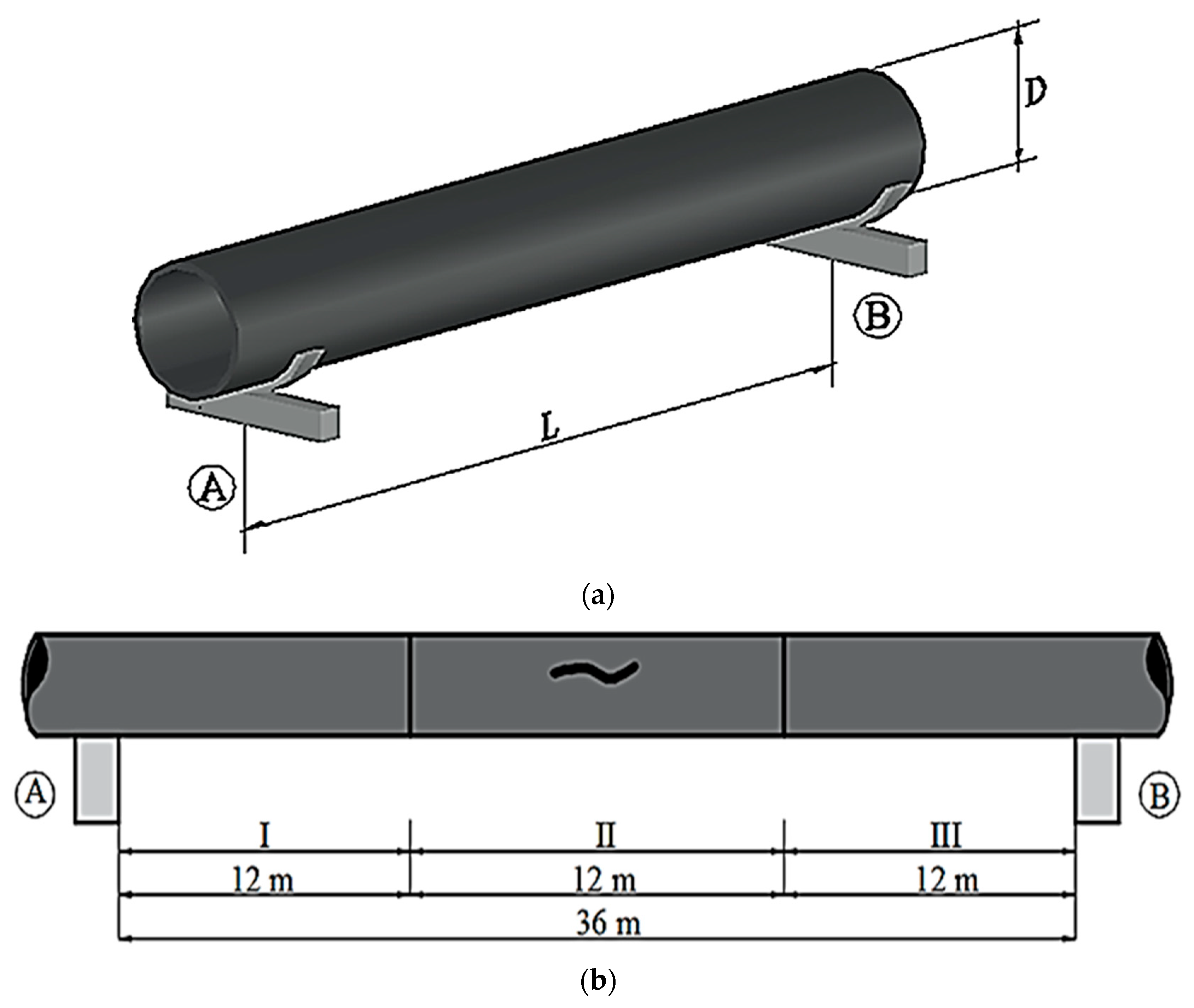
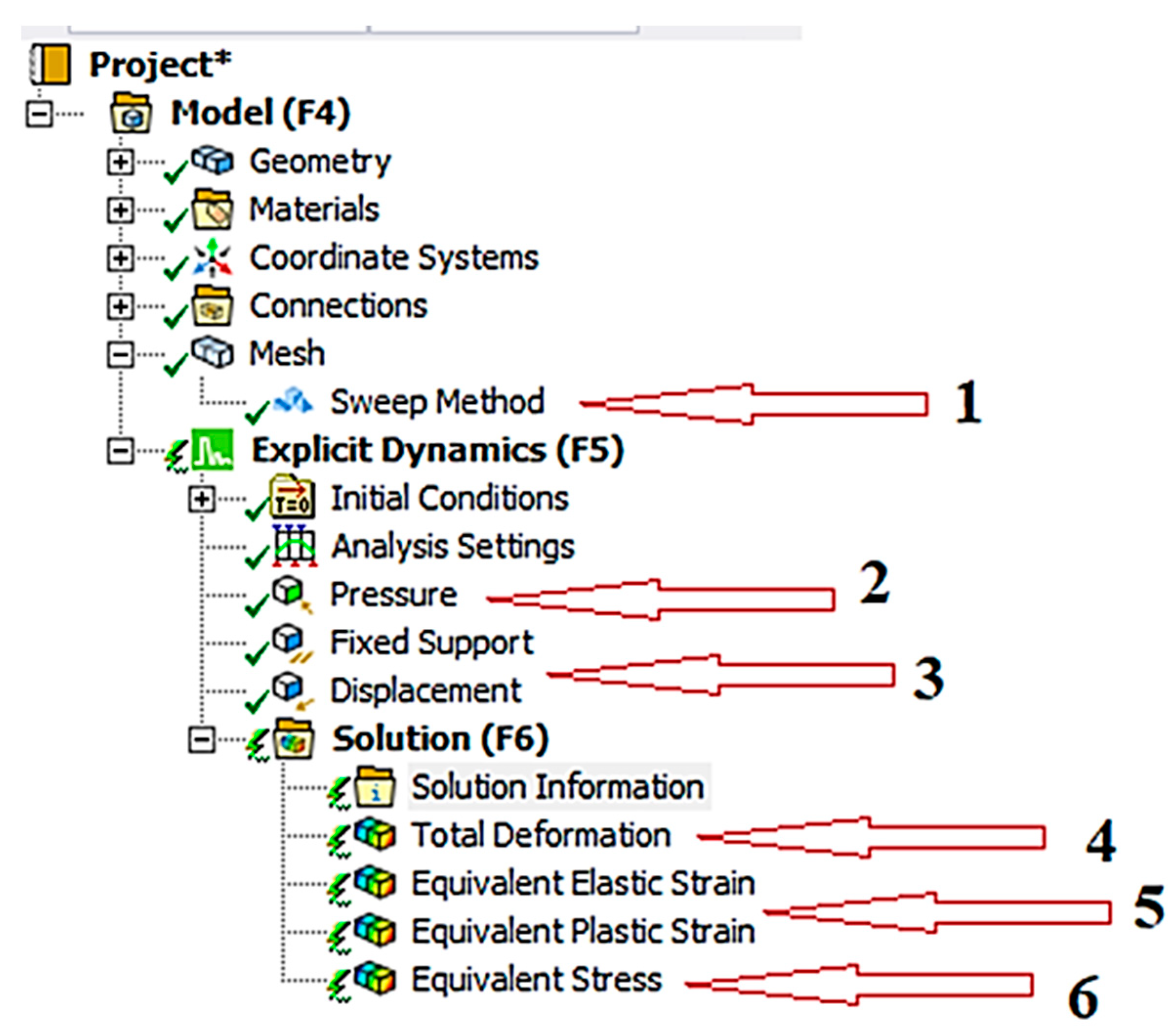
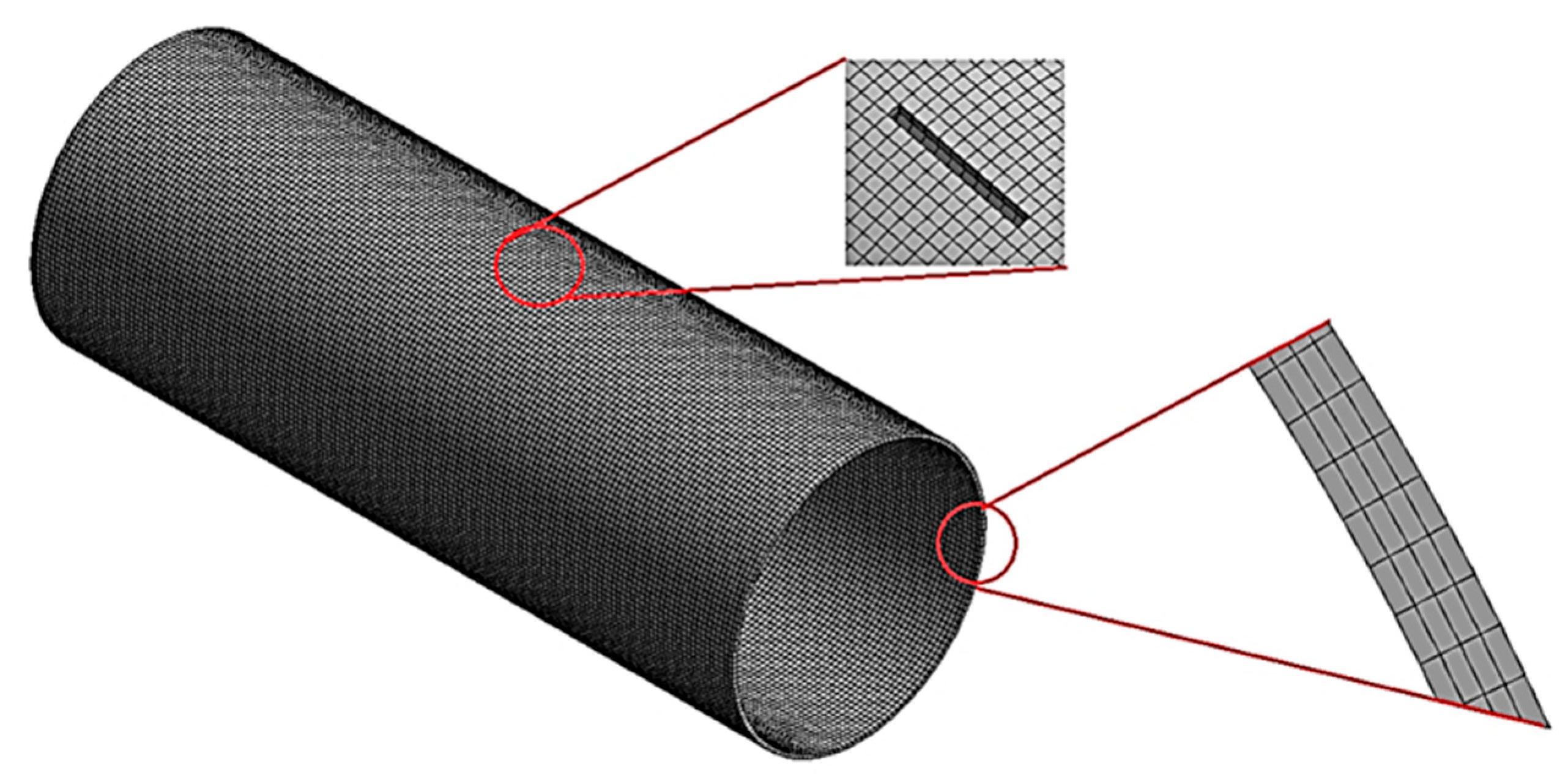
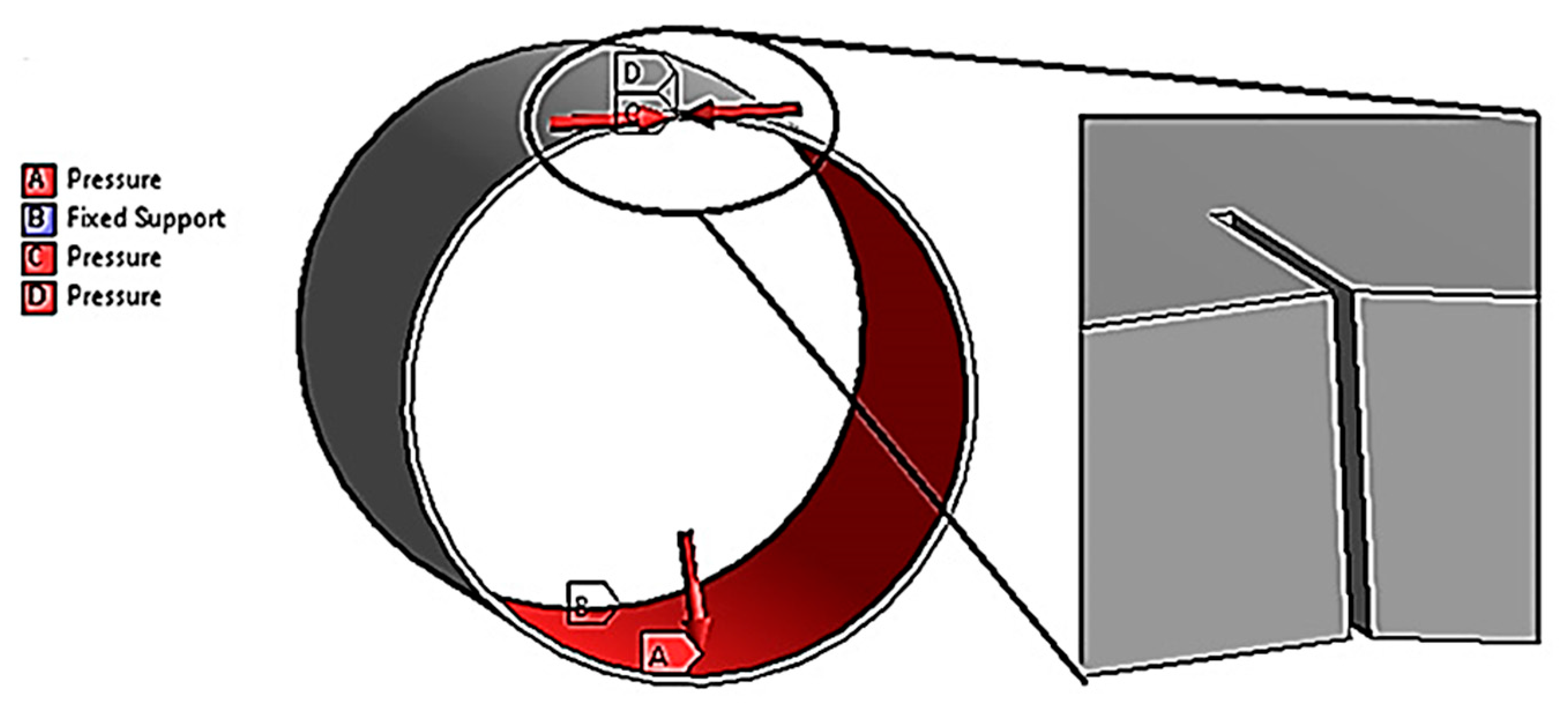

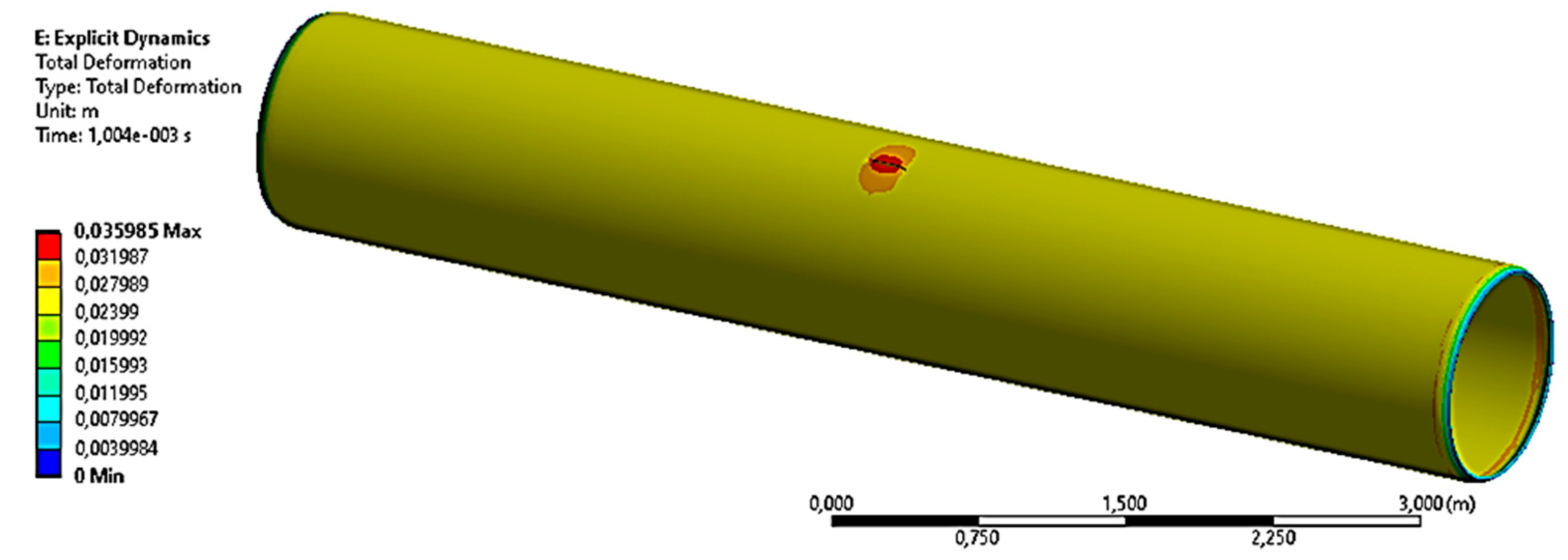
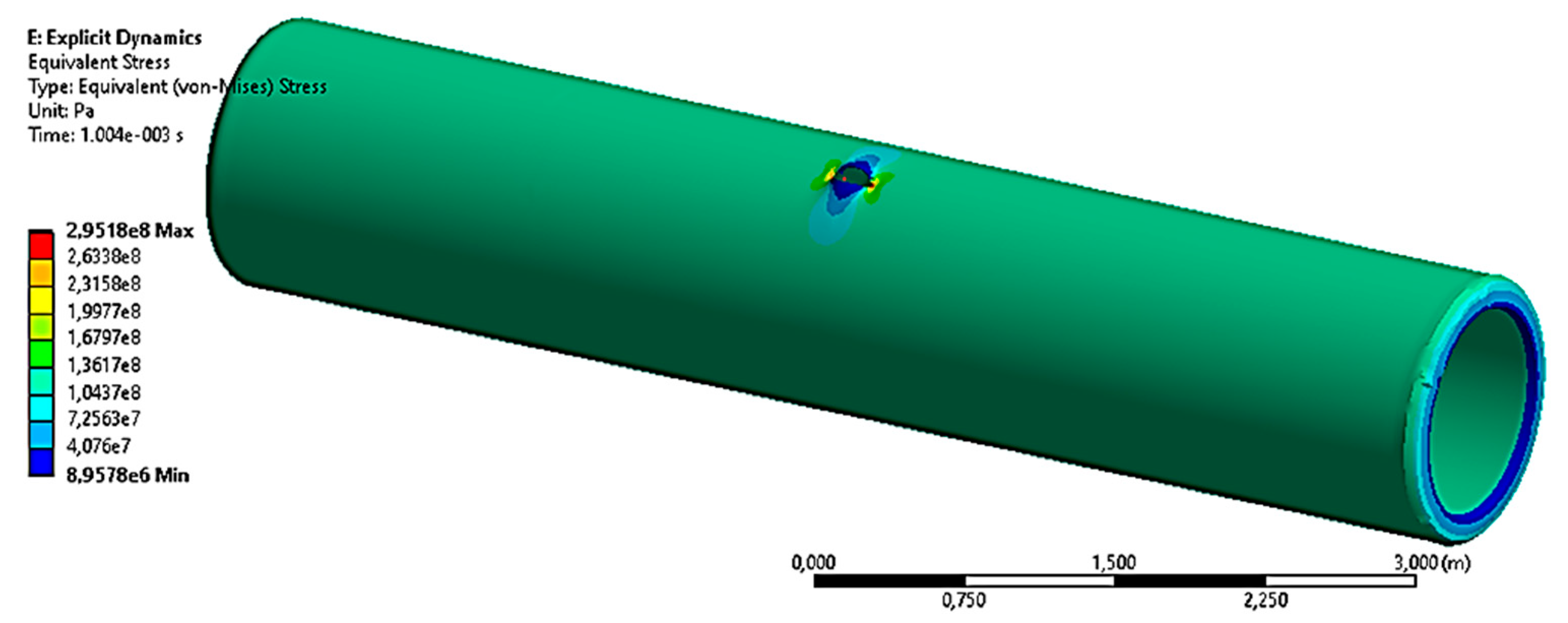

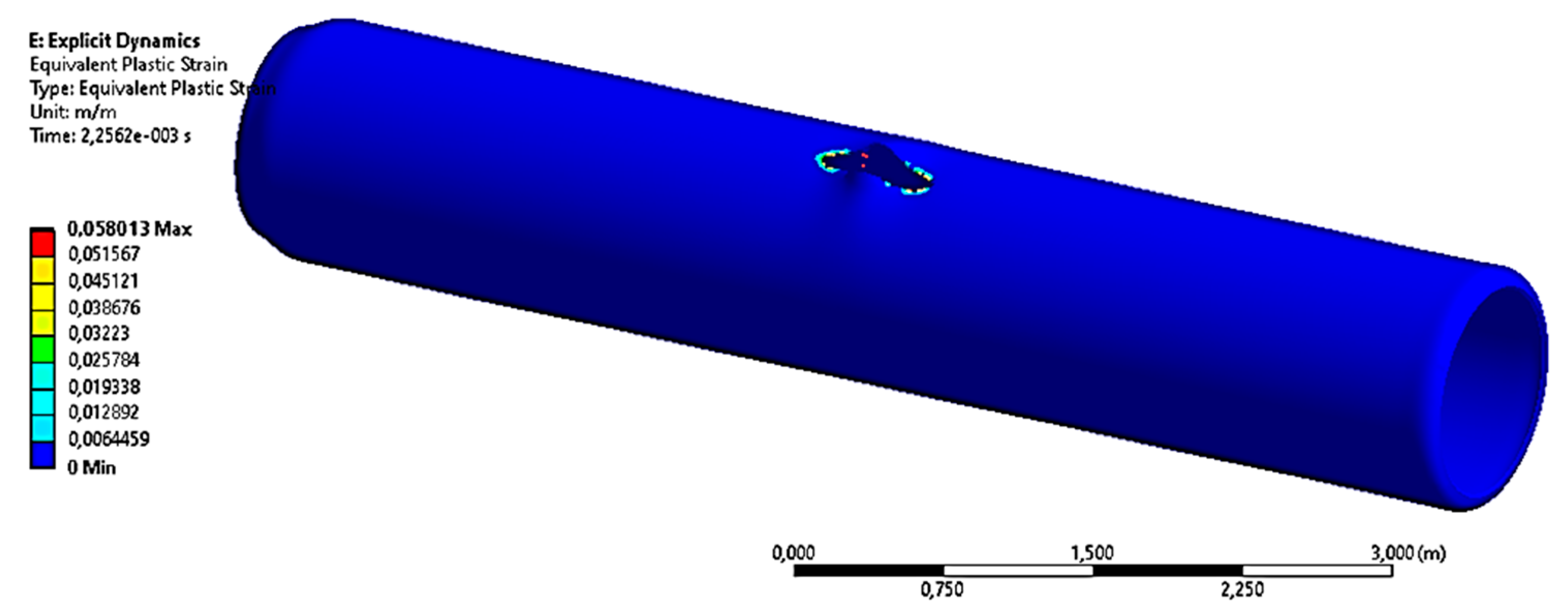
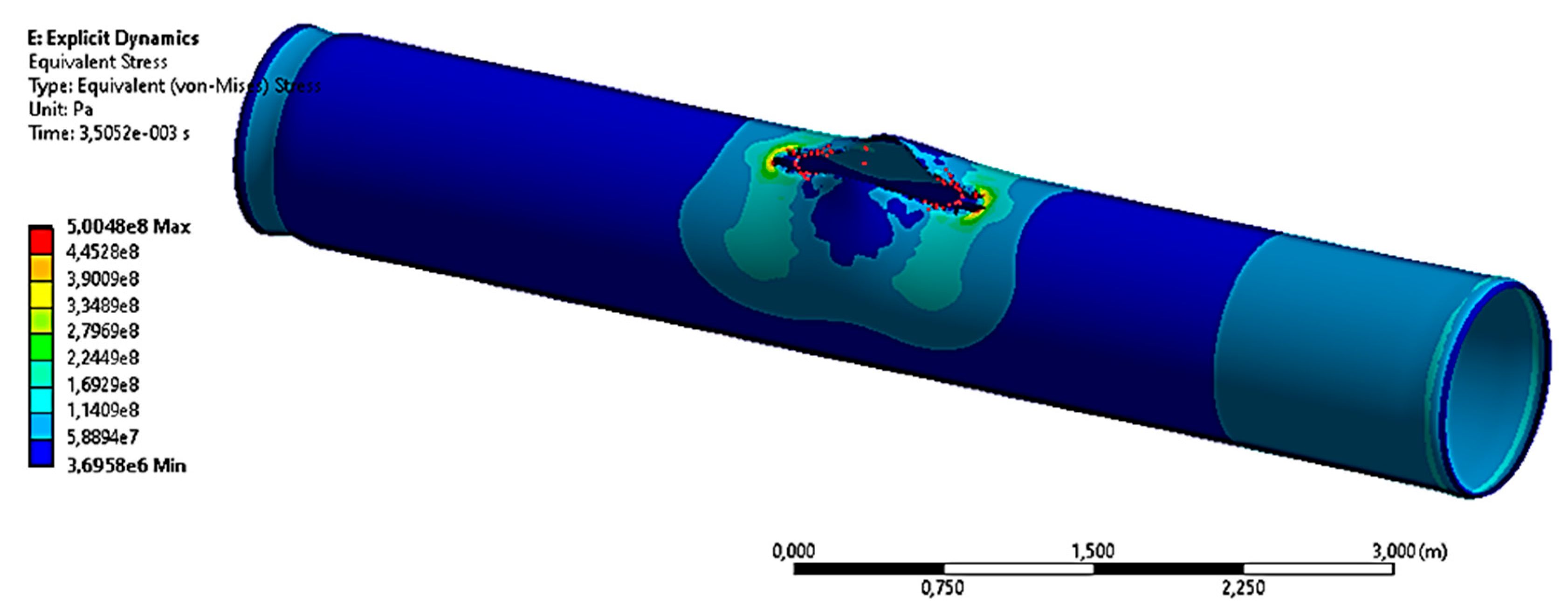


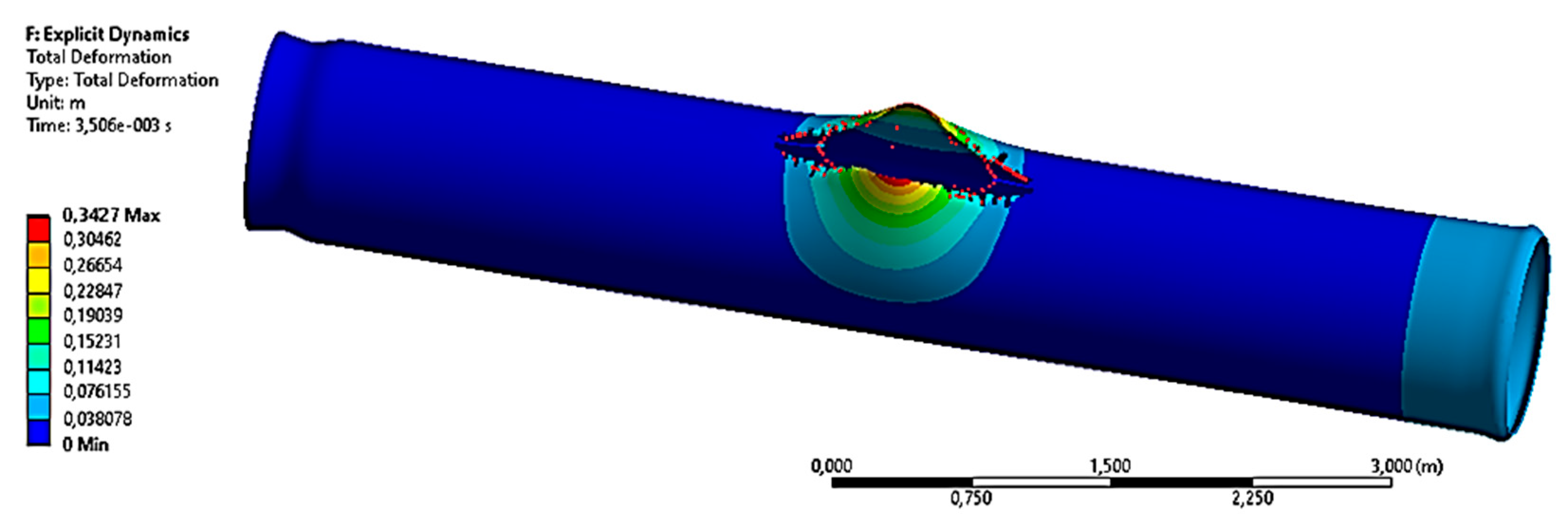
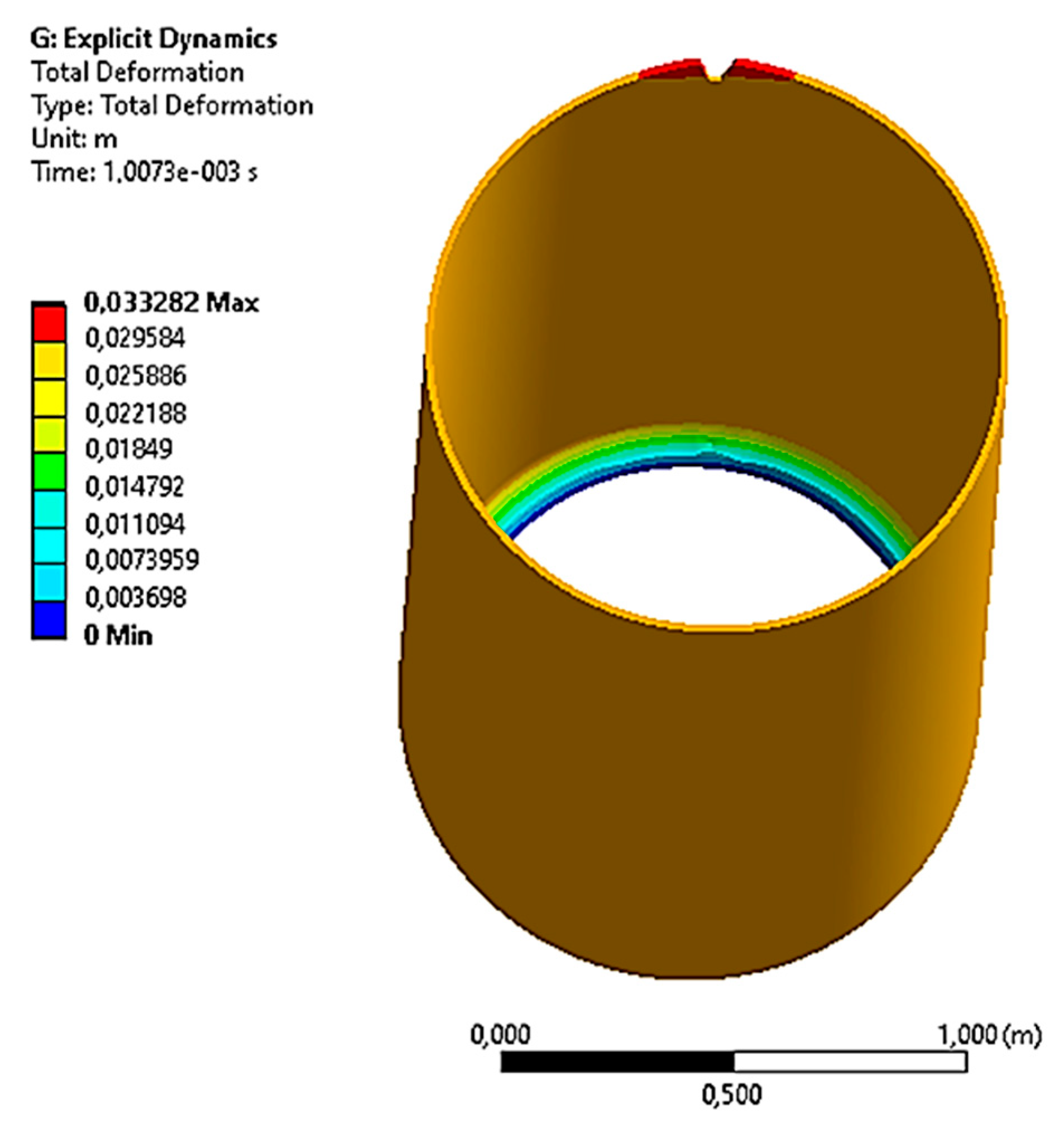





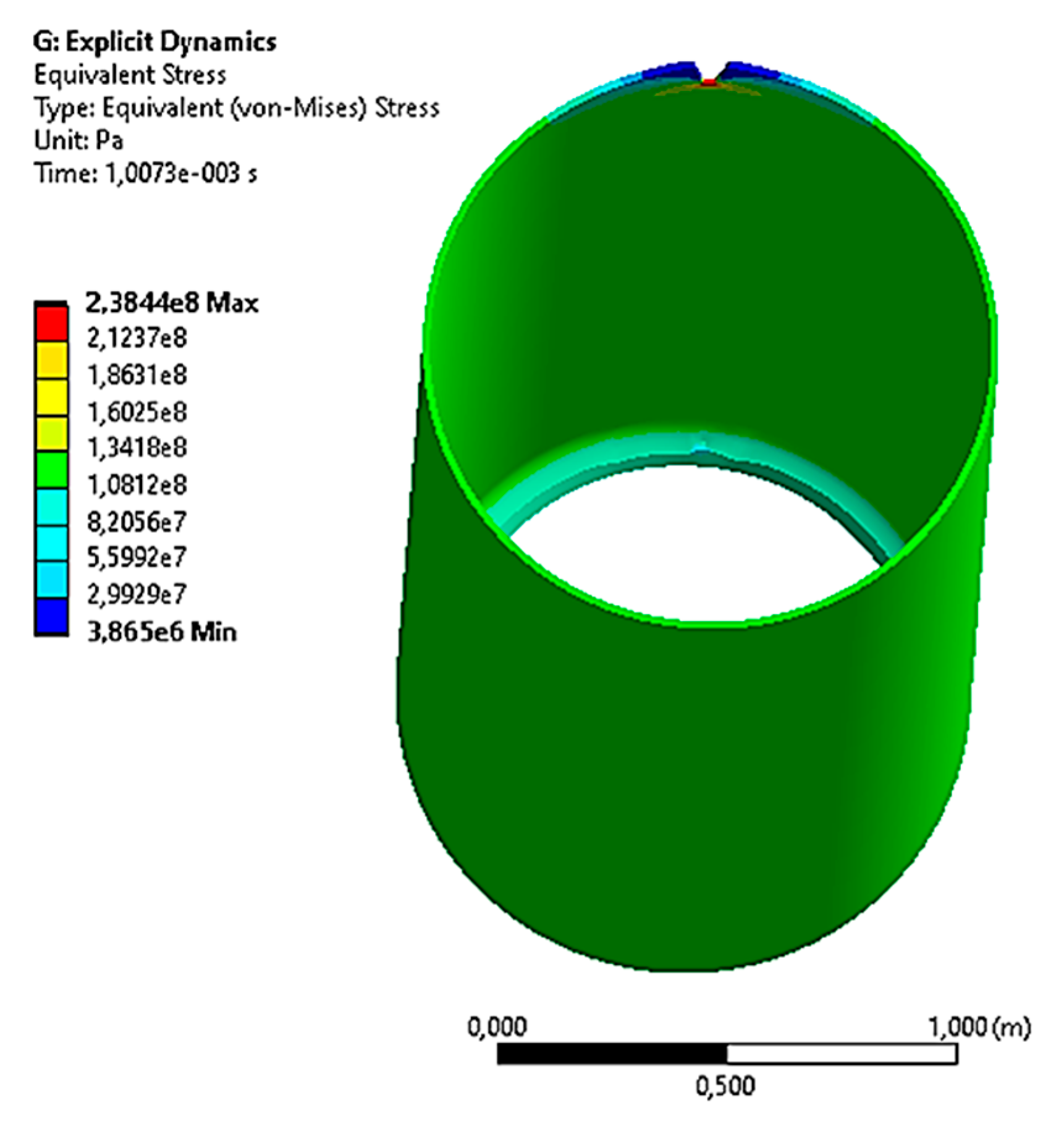
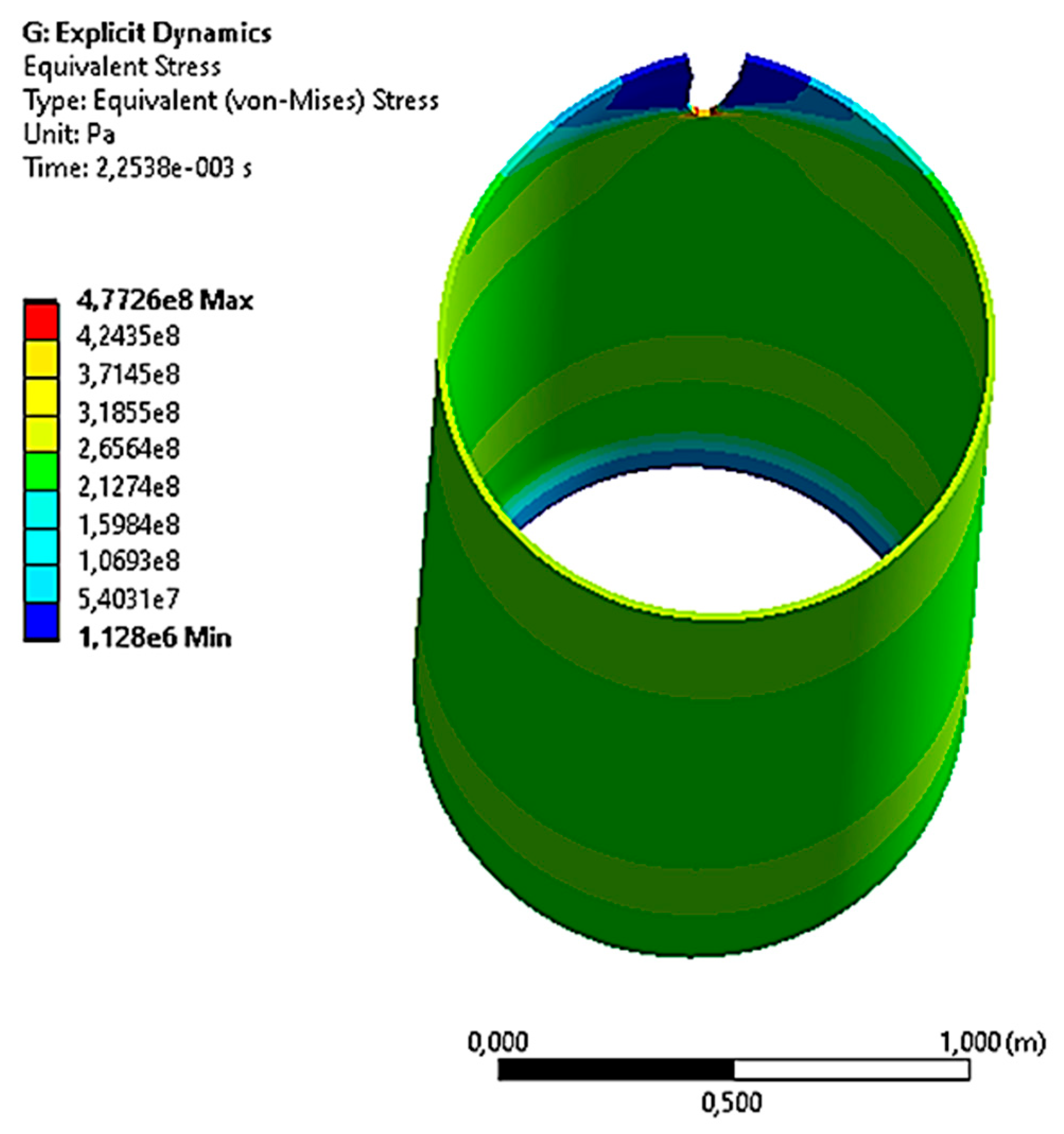

Disclaimer/Publisher’s Note: The statements, opinions and data contained in all publications are solely those of the individual author(s) and contributor(s) and not of MDPI and/or the editor(s). MDPI and/or the editor(s) disclaim responsibility for any injury to people or property resulting from any ideas, methods, instructions or products referred to in the content. |
© 2024 by the authors. Licensee MDPI, Basel, Switzerland. This article is an open access article distributed under the terms and conditions of the Creative Commons Attribution (CC BY) license (https://creativecommons.org/licenses/by/4.0/).
Share and Cite
Zhangabay, N.; Ibraimova, U.; Bonopera, M.; Suleimenov, U.; Avramov, K.; Chernobryvko, M.; Utelbayeva, A.; Uspenskyi, B. Finite-Element Modeling of the Dynamic Behavior of a Crack-like Defect in an Internally Pressurized Thin-Walled Steel Cylinder. Appl. Sci. 2024, 14, 1790. https://doi.org/10.3390/app14051790
Zhangabay N, Ibraimova U, Bonopera M, Suleimenov U, Avramov K, Chernobryvko M, Utelbayeva A, Uspenskyi B. Finite-Element Modeling of the Dynamic Behavior of a Crack-like Defect in an Internally Pressurized Thin-Walled Steel Cylinder. Applied Sciences. 2024; 14(5):1790. https://doi.org/10.3390/app14051790
Chicago/Turabian StyleZhangabay, Nurlan, Ulzhan Ibraimova, Marco Bonopera, Ulanbator Suleimenov, Konstantin Avramov, Maryna Chernobryvko, Akmaral Utelbayeva, and Borys Uspenskyi. 2024. "Finite-Element Modeling of the Dynamic Behavior of a Crack-like Defect in an Internally Pressurized Thin-Walled Steel Cylinder" Applied Sciences 14, no. 5: 1790. https://doi.org/10.3390/app14051790





